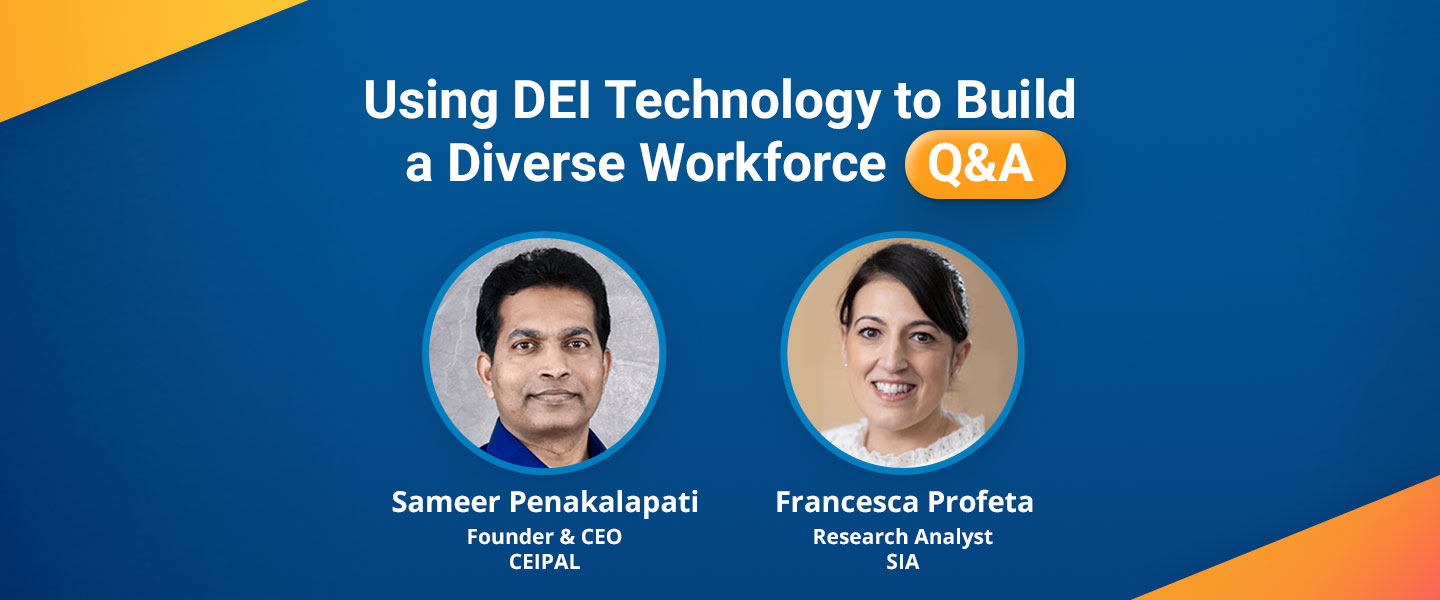Our most recent webinar “Using DEI Technology to Build a Diverse Workforce” featured Ceipal Founder and CEO Sameer Penakalapati and SIA’s lead diversity research analyst Francesca Profeta discussing one of the most challenging issues facing our sector today: the use of AI-driven technology to ensure diversity, equity and inclusion are incorporated into the talent acquisition and management process.
The webinar was so popular that we ran out of time to answer the many insightful questions that were being asked by hundreds of our attendees. So, we decided to have a follow-up conversation with Sameer as well as James Lucier, who has spearheaded many diversity initiatives. Our resident diversity expert Erica Cornier, who has also led workforce diversity efforts across New York and New Jersey was kind enough to moderate. Below is a summary of the many thoughtful talking points that resulted, which can also be found in the above video.
If you missed the original webinar, you can also access that by clicking here.
Question 1: What is the purpose of using DEI technology?
Answer: The purpose of the AI Diversity Algorithms is to provide accurate DEI metrics, analytics, and actionable insights to help clients build a more diverse, equitable, and inclusive workforce, including the contingent or external workforce.
Question 2: What types of diversity, equity, and inclusion are assessed?
Answer: The AI Diversity Algorithms assess gender diversity and ethnic diversity, as well as role and pay equity, as similarly currently defined on EEO-1 reporting.
Question 3: What data is needed to provide DEI metrics?
Answer: The AI Diversity Algorithms can infer aggregate gender and ethnic diversity metrics with sufficient accuracy for any list of 100 or more names (first name, last name) and locations. By adding job titles and pay rates, the AI Diversity Algorithms can also accurately infer aggregate role equity, pay equity, and inclusion metrics.
Question 4: What is meant by sufficient accuracy?
Answer: Sufficient accuracy means that the quality of the DEI metrics is sufficient for producing valuable information to accurately assess diversity, equity, and inclusion gaps within the sample data.
Question 5: What other types of DEI metrics are available?
Answer: Organizing, analyzing, and reporting on DEI metrics is essential to building a more diverse, equitable, and inclusive workforce. Metrics include gender diversity, ethnic diversity, ethnic diversity by gender, and role equity and pay equity by gender, ethnicity, and ethnicity by gender. Data can be drilled down to deeper levels of information and sliced and diced into smaller parts and examined from different viewpoints to gain a better understanding – i.e. by diversity by location, department, labor category, supplier, etc.
Question 6: What about data privacy and security?
Answer: Privacy, data protection, and security are designed into the infrastructure, processes, and solutions, and are regularly audited to ensure compliance with all relevant data privacy regulations. The AI Diversity Algorithms are utilized only for the purpose of inferring aggregate gender and ethnic diversity metrics. There is no reporting or use of any type of information on gender or ethnic demographics on an individual level.
Question 7: What about other types of diversity?
Answer: Gender and ethnic diversity are just two aspects of diversity. They also happen to be the types of diversity currently required, measured, and reported on EEO-1 forms. No single tool, technology, or platform currently assesses every type of diversity; maybe none ever will. But the AI Diversity Algorithms provides critical information most organizations do not have or have difficulty gathering, analyzing, and utilizing to build a more diverse, equitable, and inclusive workforce.
Question 8: What does the future hold?
Answer: Ceipal is dedicated to the use of ethical AI and machine learning to help organizations build more diverse, equitable, and inclusive workforces, including the contingent or external workforce. The DEI technology roadmap includes expanding, enhancing, and evolving current and future solutions to help organizations achieve DEI objectives at scale.











